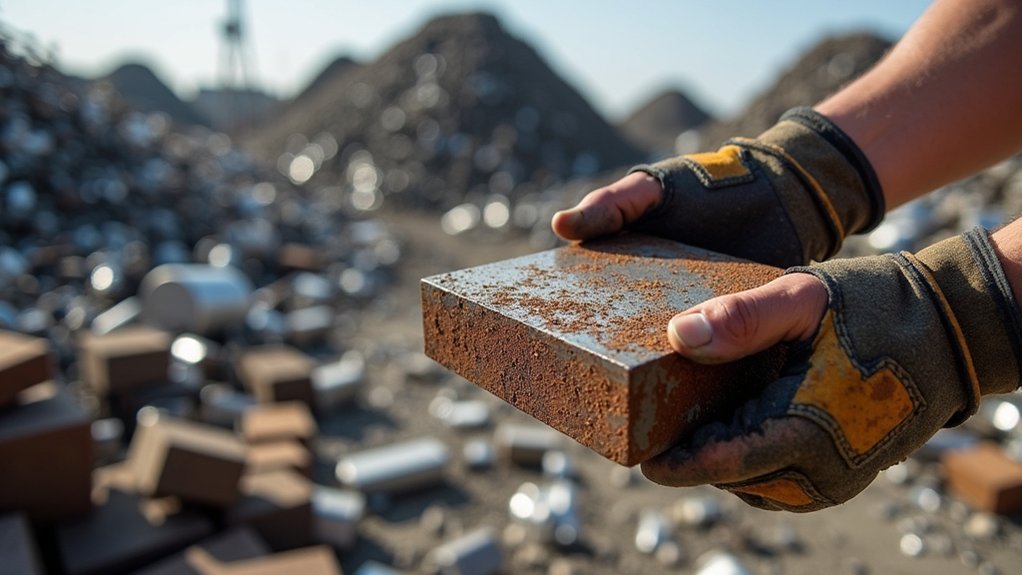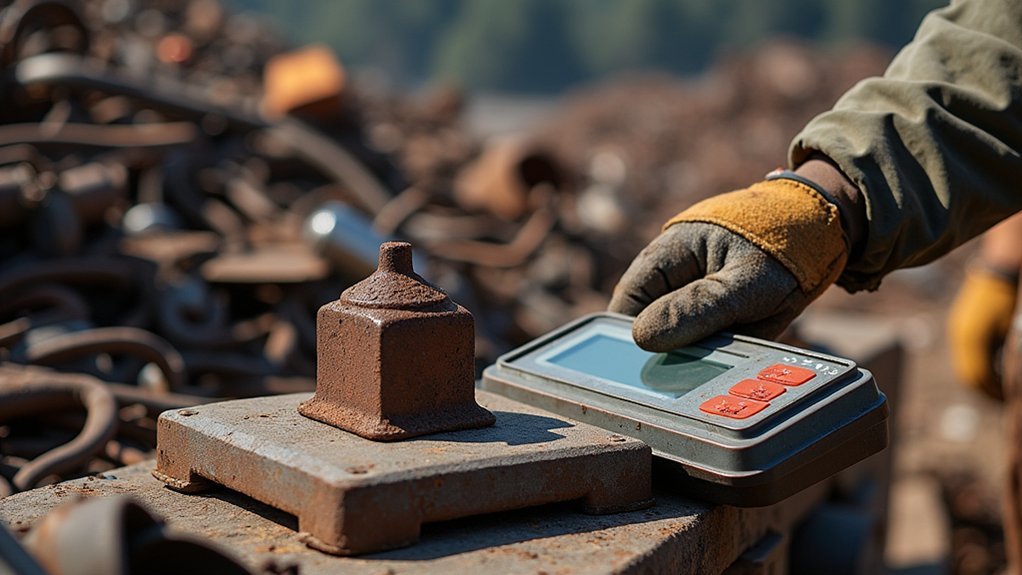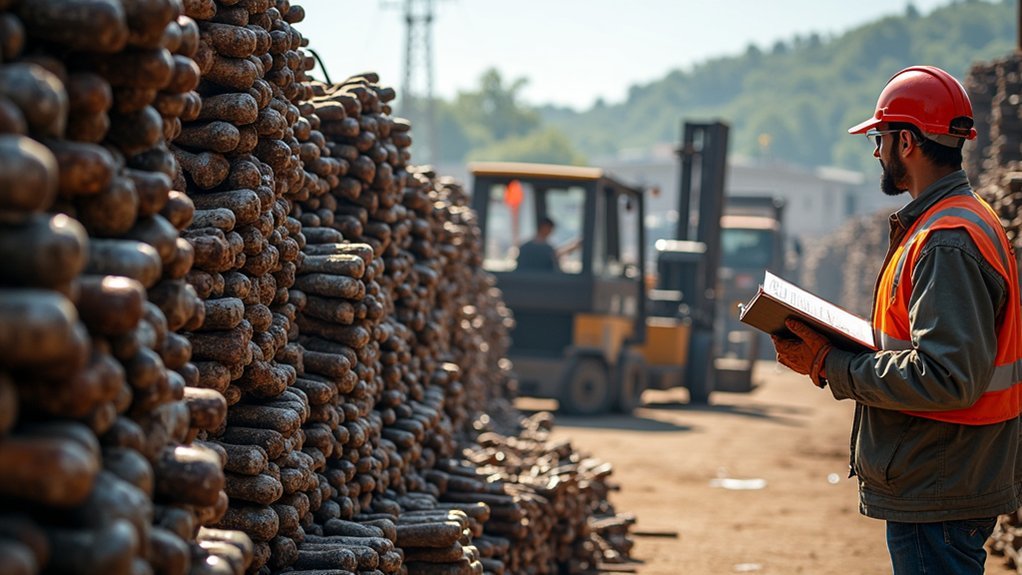When your financial aspirations intersect with industrial recycling, scrap metal becomes more than mere discarded material—it’s a potential revenue stream. You’ll want to understand the nuanced world of metal weight assessment and market dynamics. Precise measurement tools and strategic sorting can transform seemingly worthless fragments into profitable commodities. If you’re curious about turning environmental responsibility into economic opportunity, this guide will illuminate the critical pathways to maximizing your scrap metal earnings.
Key Takeaways
- Accurately measure and sort different metal types using digital scales to maximize recycling profits, with copper wire commanding the highest prices at $3-$4 per pound.
- Compare scrap yard pricing structures and quotes across multiple facilities to ensure competitive rates, considering potential 10-15% price variations in local markets.
- Clean and separate metals thoroughly before recycling, as sorted and uncontaminated materials significantly increase market value and potential earnings.
- Maintain detailed transaction records and comply with legal documentation requirements to avoid potential fines and ensure smooth, legitimate metal recycling operations.
- Optimize transportation logistics and collection schedules to reduce operational costs and improve overall efficiency in metal recycling collection and processing.
Understanding Metal Types and Their Market Values

When recycling metal weights, understanding the diverse types of metals and their market values is paramount for maximizing financial returns. You’ll want to focus on identifying specific scrap metals like copper wire, which commands the highest prices at $3-$4 per pound, considerably outperforming other metal types in the metal recycling industry.
Brass and stainless steel offer moderate profits, with brass fetching 40-60% of copper’s value and stainless steel generating $0.50-$1.00 per pound. Aluminum scrap represents a lower-tier option, typically earning $0.80-$1.00 per pound. By recognizing these market prices and metal types, you’ll strategically approach selling scrap, ensuring you’re well-informed about potential earnings and optimizing your recycling efforts for maximum financial gain.
Essential Tools for Measuring Scrap Metal Weights

Knowing the market value of scrap metals sets the stage for precise measurement techniques that maximize your recycling returns. Your success in metal recycling hinges on accurate weight measurement:
Precise metal measurement transforms scrap recycling into a strategic, profitable venture of maximum returns.
- Digital Scales: Invest in a reliable digital scale with 0.01-pound precision to guarantee fair pricing at scrap yards.
- Portable Hand-Held Scales: Quick weight checks help you estimate potential profits before visiting recycling centers.
- Tracking Logs: Maintain detailed records of metal weights to optimize future scrap management strategies.
Industrial scales at scrap yards can handle up to 10,000 pounds, making it essential to understand your metal volume. By leveraging the right measuring tools, you’ll transform scrap metal collection into a more profitable and strategic endeavor, guaranteeing you’re paid accurately for every ounce of recyclable material.
Top Strategies for Maximizing Scrap Metal Earnings

Since scrap metal recycling represents a potentially lucrative endeavor, strategic approaches can markedly enhance your earnings potential. By sorting different metals and understanding scrap metal prices, you’ll maximize profits considerably. Separate copper, aluminum, brass, and steel to receive higher rates, as mixed metals reduce overall value. Clean metals thoroughly, removing insulation and contaminants to increase their market worth—bare bright copper wire commands up to 30% more than insulated versions.
Monitor market trends to identify the best time for selling your scrap, typically during spring and summer months. Call multiple scrap yards to compare quotes, ensuring competitive pricing. Transport larger quantities to meet minimum weight requirements and optimize your returns. Detailed preparation and strategic selling can transform your recycling efforts into a more profitable venture.
Navigating Local Recycling Center Pricing Structures

How do you maximize your scrap metal earnings when maneuvering through the complex landscape of local recycling center pricing structures? Consider these strategic approaches:
- Call multiple scrap metal near facilities to compare prices, recognizing that pricing structures can vary by 10-15% between locations.
- Investigate processing fees and minimum weight requirements that might impact your profitability when you sell scrap.
- Assess transparency in pricing by checking for certified scales and staff knowledgeable about current market trends.
Understanding regional market conditions is vital. Different yards offer distinct rates for specific metals, making thorough research essential. By staying informed about fluctuating scrap metal values, you’ll optimize your earnings. Prioritize yards with clear pricing signs, detailed market insights, and competitive rates to guarantee you’re making an informed decision about where to sell your recyclable materials.
Sorting and Preparing Metals for Optimal Profit

After comparing local recycling center pricing structures, metal recyclers must strategically approach sorting and preparing scrap for maximum financial return. Sorting metals by type can dramatically increase profits, with potential earnings rising up to 170% when properly separated.
| Metal Type | Cleaning Impact | Profit Potential |
|---|---|---|
| Copper | High | +30% value |
| Aluminum | Medium | +15% value |
| Brass | High | +25% value |
| Ferrous | Low | Base price |
Cleaning metals by removing non-metallic contaminants is vital. Bare bright copper wire, for instance, commands appreciably higher prices than insulated alternatives. Weighing clean, sorted metals and tracking market prices enables recyclers to optimize selling strategies. Understanding current scrap yard prices and maintaining detailed transaction records will help maximize profit in this dynamic aluminum and metal recycling market.
Legal Considerations in Scrap Metal Recycling
While traversing the complex landscape of scrap metal recycling, you’ll quickly discover that legal compliance is as critical as understanding market prices. Steering through the intricate web of local and federal regulations requires meticulous attention to detail in your scrap metal transactions.
Key legal considerations include:
- Maintaining extensive seller identification records
- Adhering to specific documentation requirements for non-ferrous metals
- Understanding jurisdiction-specific restrictions on metal sales
Recycling yards must implement robust systems to track transactions, ensuring transparency and preventing potential illegal activities. Failure to comply can result in substantial fines, license revocation, and criminal charges. Your success depends on understanding these legal nuances, carefully documenting each sale, and staying informed about changing regulations in scrap metal recycling.
Advanced Techniques for Identifying High-Value Metals
Mastering the art of identifying high-value metals can transform your scrap recycling endeavors from mundane to profitable. Advanced techniques involve strategic sorting and thorough market knowledge. Use a magnet to quickly distinguish between ferrous and non-ferrous metals like copper and brass, which command markedly higher prices. Clean, bare metals—especially bright copper wire—yield maximum returns, so meticulously remove insulation and non-metallic contaminants.
Monitor current market trends to optimize your metal recycling strategy. Track price fluctuations and focus on components like electric motors and compressors that offer considerable value. Understand that copper can be 30-40 times more valuable than steel, making precise identification essential. By developing a keen eye and implementing systematic sorting methods, you’ll maximize scrap yard profitability and turn metal recycling into a lucrative venture.
Transportation and Logistics of Scrap Metal Collection
Once you’ve identified high-value metals, transforming those insights into profitable recycling requires strategic transportation and logistics planning. Maximizing your scrap metal collection’s profitability hinges on smart logistics management:
- Minimize transportation costs by prioritizing local scrap yards, which can boost profit margins by 10-15%
- Develop regular pick-up schedules for high-volume contractors to streamline collection efficiency
- Utilize container drop-off services to consolidate scrap metal and reduce per-trip transportation expenses
Understanding local regulations is critical to preventing legal complications during transportation. Strategic planning allows you to optimize logistics, reducing fuel expenses and maximizing returns. By carefully managing transportation routes, container usage, and collection schedules, you’ll transform metal recycling from a basic operation into a precision-driven, financially rewarding enterprise.
Frequently Asked Questions
Can You Recycle Weights for Money?
You can recycle weights for cash by sorting metal types, understanding scrap value, and checking local regulations. Different weight materials like cast iron and brass offer varying profit margins while supporting environmental benefits through recycling processes.
What Brings the Most Money at Scrap Yard?
Copper’s gleam meets steel’s dull shine: you’ll maximize scrap yard earnings by prioritizing copper and brass, understanding local market demand, and meticulously sorting metals to optimize recycling processes and profit margins.
Do Scrap Metal Yards Make Good Money?
Yes, scrap metal yards can make substantial money by leveraging competitive rates, understanding market demand, and efficiently processing various weight types through sustainable recycling practices that optimize profit margins in this dynamic industry.
Can You Sell Weights as Scrap Metal?
You’ll find scrap yards enthusiastically buy weights based on metal composition, with ferrous and non-ferrous types fetching different values. Clean, well-maintained weights maximize your recycling potential and contribute to sustainable metal reclamation efforts.
Conclusion
You’ve learned that success in scrap metal recycling isn’t just about collecting—it’s about strategy. Remember, “One man’s trash is another man’s treasure.” By mastering precise weighing techniques, understanding metal classifications, and staying informed about market dynamics, you’ll transform recycling from a side hustle into a profitable venture. Your technical approach and resourceful mindset will be your greatest assets in steering through this lucrative industry.





